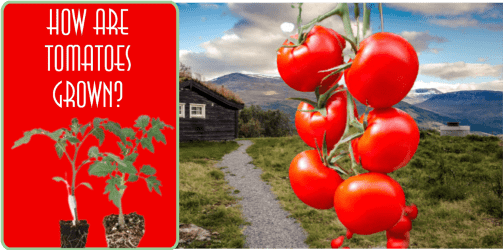Tomatoes are consumed around the world fresh, cooked together with other vegetables. Tomatoes are used in food, tomato juice, concentrated tomato juice, brine, canned food, tomato paste, ketchup, sauce, pulp and puree are used by freezing and drying.
Tomatoes are rich in vitamins and minerals. one hundred gr. fresh tomatoes 20-23 calories, 1 g protein, 0.3 g fat, 0.6 g ash, 93.8-96.0% water, 4 g carbohydrates, 2-3.5% sugar, 0.6 g cellulose, 7.21 mg calcium, 17-28 mg phosphorus, 0.6 mg iron, 1000-1100 IU vitamin A, 264-314 mg potassium, 19-20 mg magnesium, 24-69 mg chlorine, 17-28 mg phosphorus, 3-10 mg sodium, 0.5-0.8 mg niacin, 20-28 mg vitamin C, 0.09 mg It contains thiamin, 0.03 mg riboflavin, 0.40-0.80 mg vitamin K.
In what climate do tomatoes grow?
In tomatoes, it is usually 6 ºC between night and day. It is desirable to find a difference of 8ºC with 19- Growth is good when 26 ºC, night temperature 14-18 ºC. Tomato is a hot and temperate climate vegetable. Growing When the temperature drops below zero (-2,-3 ºC) in the dies completely. Late spring when planting seedlings in the field frosts must end. Fertilization is closely related to temperature. Tomato pollen at 10 ºC and above fertilization can be done by germinating as desired and temperature below 15 ºC fruit when it falls tying percentage is decreasing. Low pollen dust at temperature very little occurs, partial fertilized amorphous fruits occur income. over 40 ºC flower the dust dies, the plant is damaged. Minimum 10 ºC for germination of tomato seeds, Optimum soil temperature of 20-29 ºC, maximum 36 ºC compulsory.

Soil preparation for planting tomatoes
Tomato; permeable, good water retention, humous and likes loamy soils rich in nutrients. Earliness Sandy loam soils are suitable when desired. Tomato, Soil pH 3 between 5.5-7.0, salt-free to low salt (less than 2.3 mS) grows well in soil. If the soil pH is below 5.5, per decare 200-500 kg of lime should be given, if the pH is above 7.0, every year 30-50 kg of powdered sulfur should be given per decare.
How is Tomato Seed Planting done?
Sowing seeds after soaking in water for 3-4 hours facilitates germination. Seeds 1-3 cm. in depth should be planted. Lightly watered again after planting. Chemical fertilizer is applied fifteen days after tomato planting. Optimal soil temperature for germination of seeds It should be 12-15 ºC. At these temperatures, seeds germinate in an average of 10 days. Since the tomato plant is a deep rooted plant, The soil must be carefully prepared by deep ploughing.
- 3-4 tons of well-burned barnyard manure per decare in autumn must be thrown and driven deeply.
- Fertilize properly in spring.
- Remaining fertilizers fruits on plants should be given when seen.
- When the fruits are the size of hazelnuts, 10-15 days apart. Magnesium nitrate applications to be made 2-3 times (100 lt water 400-600 grand foliar fertilization positively affects fruit quality.
- Before planting the seedling, the field is 20-30 cm deep. is driven.
Planting tomato seedlings
- Seedling planting, when the danger of spring frost is completely removed, It is done when the soil and air temperature reaches 12-15 ºC.
- Planting is usually about 7-8 weeks after seed planting.
- Tomatoes that bloom or set fruit when planted in the field seedlings should not be planted.
- Growth of such seedlings is slow. It remains stunted and its yields decrease. Tomato seedlings grow slowly.
- When the seedlings are about 15-20 cm tall, they are usually planted.
- In planting, life water should be given enough.
- Spacing between rows and above in tomato cultivation, depends on whether the variety is pole or ground variety.
Tomata Pruning; In open field tomato cultivation, and pruning is done to obtain quality products in pole tomatoes. Two leaves of the last cluster to be left The cutting of the top shoot of the plant is called tip picking.
Tomato diseases; Early blight, downy mildew, leaf blight, bacterial spot, bacterial cancer and wilt, tomato mosaic virus, tomato yellow leafroll virus.
Tomato pests; Nematodes, gray wolf, danaburnu, wireworm, leaf lice, whitefly, Empoasca, thrips, leaf gallery flies, red spiders, hay mites, green worms and other suckers insects.